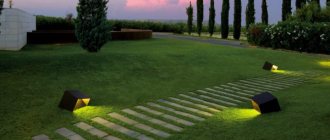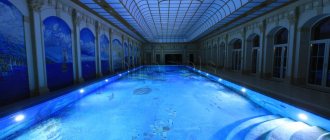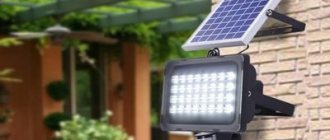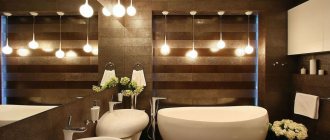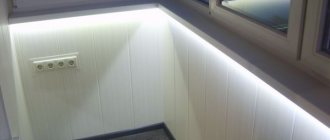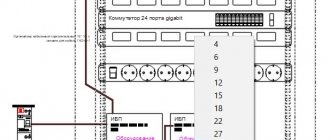What kind of lighting can be used in a dacha?
The following type of lighting can be installed at a summer cottage:
1. General.
2. Decorative.
3. Technical.
4. Security.
5. Marking.
Each option has its own characteristics and tasks.
General lighting of a summer cottage
Its task is to illuminate the main area. With light of such intensity, you can not only relax on a cozy veranda, but also carry out any work. The main sources of light emission here are lanterns on supporting poles and wall-type lamps mounted on brackets.
Illumination of the main area
Decorative type of lighting
Organizing decorative lighting for a summer cottage is a real pleasure. The work is creative and does not limit the flight of imagination, which is why many owners prefer to create such lighting in their dacha with their own hands. The most incredible ideas can be used here and any lighting devices can be used: from banal candles to LED strips. Decorative lighting does not carry any special functional load. She simply creates a picturesque picture.
Decorative lamps will decorate the area
Technical lighting
Lighting for a summer cottage of this type is considered necessary. The light from the lamps highlights the garage entrance, greenhouses, and outbuildings. The same type of lighting is used to illuminate the fence in the gate area.
Technical lighting of functional areas
Technical lighting is an integral part of security lighting, so it must be immediately made of high quality, using modern lamps and adjustable guide structures.
Security street lighting in the country
A well-lit area will never attract the attention of thieves. The development of the project should be entrusted to professionals. Only they can arrange the lighting fixtures so that there are no shaded corners left on the site, but at the same time the idyll of contact with nature is not disturbed.
Home security lighting diagram
Marking lighting
It identifies specific areas of territory or buildings that need lighting. Most often, benches, steps, and entrance groups are designated in this way. The category of marking lighting also includes lighting for a fence with a gate.
Marking lighting for steps
Which form of LED lamps is better?
It depends on the purpose of the lighting device. Among the variety of LED models, three are the most popular: Pear. This is the most common type of LED light bulbs; it looks similar to a traditional incandescent lamp with a luminous flux distribution angle of 180 to 360 degrees. Suitable for almost any chandeliers, lamps and other devices. Corn . Reminiscent of a corn cob, with “grains” in the form of ice crystals. It glows brightly, but there is little illumination. Such models are used in spotlights.
Candle . Very compact, with low luminosity (500-600 lm), suitable for night lights, table lamps and other local lighting devices.
Decorative lighting for a country house
There are several ways to organize the lighting of a country cottage. The very purpose of its arrangement is important here. If the owners want to emphasize the architectural charms of the facade, its relief, etc., then the light flux should be poured horizontally onto the wall surfaces. This effect will be achieved by LED strips, LED garlands, and yellow (warm) lamps mounted directly on the walls of the house.
Decorative lighting for a country house
For security lighting of a summer cottage, they do things a little differently. The house is flooded with powerful light emanating from lanterns, spotlights and other similar devices located at a certain distance from it. To maintain the grace of the object and not turn the illuminated area into something like a prison zone, halogen and fluorescent lamps should be used in lanterns.
What technical characteristics of LEDs should you pay special attention to when purchasing?
When it comes to diodes, slightly different parameters are important than in traditional types of electric lighting. The most important parameter is luminous flux (lm or lm). It shows how much light energy the lamp gives off. They also use the “luminous efficiency” (lm/W), which indicates how effective the light device is.
Luminous flux is inextricably linked to color temperature , which shows in what shade the lamp glows. Color temperature is measured in Kelvin. Experts recommend warm colors for residential premises, and neutral colors for the office, kitchen and bathrooms. If the lamp uses LEDs with TC≥5300°K, it is not suitable for home lighting.
Another important indicator is power . The power of a LED lamp is calculated using the formula:
Divide the desired wattage of a traditional incandescent lamp by eight.
But manufacturers usually mark the LED lamp with the power values of an incandescent lamp that correspond to it.
When choosing an LED lamp, the dispersion angle - this parameter shows how widely the light flux spreads in space. A lamp for general use must have an angle of at least ≥210°.
Dale85FORUMHOUSE user
And where directional light is needed, a lamp with a dispersion angle of 120 degrees is suitable.
Lighting the veranda at the dacha
“Chinese lanterns and hidden lighting are actively used in the decorative lighting of the veranda of a country house”
It's no secret that the veranda is a favorite place for spending leisure time at the dacha. It is especially pleasant to sit on it in the evening. Decorative lighting for the veranda at the dacha will help add comfort to the atmosphere and make the corner original and stylish. It is organized both indoors and outdoors.
In the first case, electric light emitters are used. You can use both devices made for lighting a summer cottage with your own hands, as well as store-bought models. Entire garlands of lamps, spotlights, and floor lamps may appear on the veranda.
Decorative lighting for the veranda
The choice of their design is purely a matter of taste. Extravagant designs made of bright balls and beads, the shine of austere metal, ornate carved or colorful plastic lampshades - all this is appropriate in lighting a summer cottage and has a right to exist.
The main guideline when choosing an option is the atmosphere that is planned to be recreated on the veranda in the evening: intimate and cozy or brightly festive. Chinese lanterns and hidden lighting are actively used in the decorative lighting of the veranda of a country house.
Decorative lighting of the veranda using garland
In the second case, it is more correct to use solar lighting devices for the dacha. Their dim glow will create an amazing soft illumination of the surrounding area.
Wind power plants for summer cottages
The topic of wind power plants is very broad and requires special attention. Such power plants are used for dacha lighting less often than solar panels, but this option should not be completely ruled out.
Components
The wind power plant includes:
- Blade rotor. There can be 2, 3 or more blades.
- Gearbox. Changes the rotation speed between the generator and the rotor.
- The “tail” of the windmill directs the structure into the wind.
- Frame. Protects internal elements of equipment from mechanical impacts.
- Battery. Accumulates electricity and releases electricity under adverse weather conditions.
- Inverter. Converts direct current to alternating current.
Classification
Wind turbines are classified according to several criteria that must be taken into account when choosing equipment.
In the direction of rotation of the blades:
- horizontal;
- vertical (more stable).
Number of blades:
- two;
- three;
- multi-lobed.
According to the material:
- hard;
- sailing (more affordable, but less durable).
Control type:
- fixed step;
- changing step.
Operating principle
A wind power plant works on the following principle. The wind rotates the blades fixed on a metal mast. As a result of rotation, the generator rotor begins to work, which produces alternating current.
The latter enters the converter, where the alternating voltage is converted into direct voltage. A wind of 4-5 m/s is sufficient for operation.
According to the operating principle, wind generators can:
- Work in parallel with solar power plants (batteries), gasoline (diesel) generators, backup batteries.
- Autonomous.
Selecting the size and installation location
When choosing dimensions, it is necessary to determine the amount of energy consumed. For the calculation, the formula is used: AEO = 1.64*D*V, where:
- AEO - the amount of electricity consumed per year;
- D—rotor diameter (m);
- V is the average annual wind speed (m/sec).
Taking into account the information received, a decision can be made on the parameters of the wind turbine.
When determining the installation location, consider the following:
- There should be no trees, buildings or other objects nearby that could interfere with the work.
- Installation is carried out on a special structure, which must be several meters higher than the obstacle located at a distance of at least 200 m.
- The distance from the windmill to residential buildings is about 30-40 m to reduce the sound from the rotation of the blades.
Wind power plants have certain advantages. Their effectiveness does not depend on the time of year, and the payback period is 5-7 years. Parts wear out slowly, so the equipment can last more than three decades.
But there are also disadvantages: a high mast, the need for constant maintenance and the risk of equipment damage when weather conditions worsen.
Fence lighting
“Thrifty owners make the most of the energy of solar lighting for their dachas and instead of electric lamps use their analogues powered by solar panels”
Since the fence is the “face” of the site, to organize its lighting you need to choose aesthetic lamps that have a level of moisture and dust protection within IP 43. The most popular are practical and at the same time inexpensive lamps in the form of a transparent plastic bulb. Models with glass lampshades are more attractive and have better light output, but you will have to pay more for them.
Country fence lighting
Lamps differ not only in appearance, but also in the method of mounting. When organizing fence lighting with your own hands, you need to choose the design that will be more comfortable to work with.
The first option is the so-called cap. Lamps are placed along the top of the fence. The design is practical, well protected, giving the fence an original look. This type of fastener is considered the most reliable, but it is not suitable for every type of fence.
Lamps with hoods are placed on top of the fence
Wall lamps are considered universal and have a chic look. They are fixed with brackets. You can even mount them on fences, but it is more rational to use them not for street lighting of a summer cottage, but by installing them from the inside. From the outside, they can easily be damaged, or even removed altogether.
Wall lights for fence
Thrifty owners make the most of the energy of solar lighting for their dachas and instead of electric lamps use their analogues powered by solar panels. They do not produce too bright a glow, but they are incredibly good at decorative lighting of a country house.
Solar fence light
If, nevertheless, the balance is tipped towards electrical appliances, then equip them with LED lamps, which have excellent characteristics and are economical in “eating” energy. Their service life exceeds 5 years, so the seemingly unprofitable prices are very optimal.
The service life of LED lamps exceeds 5 years
The second element acceptable for lighting a fence in a country house is incandescent lamps. They shine well and cost little, but that’s where their positive characteristics end. An ordinary lamp will generate a lot of kilowatts, it will have to be changed monthly, if not more often, and they can explode when exposed to moisture.
Lanterns with incandescent lamps for illuminating the fence
Automation of turning on and off country lamps
Even at the stage of drawing up a diagram of the location of lamps on the site, you need to decide how they will be turned on and off. Someone will want to do this on their own every day, but in the case of a large area, it is quite problematic to constantly turn the lamps on and off. This is especially true when you don’t come to your dacha very often. But there is a way out - automation of the lighting system, and there are several options for bringing this idea to life:
- control of a twilight relay, which will turn on the lighting when the sensor installed on the site “feels” the onset of twilight, and turn it off at the onset of dawn. Installation of the sensor is possible in any convenient place on the territory; the relay is mounted in the electrical panel;
- astronomical relay control. In this case, no additional sensor is required - you just need to set the location coordinates once, and the built-in microprocessor will calculate the time of sunset and dawn at a certain time of the year. Such a relay can be additionally configured not to turn on the light if there is no one on the site. Thanks to the built-in battery, the relay retains all settings during a temporary power outage. Mounted in electrical panel;
- controlling a time relay is the simplest and not very functional option. It only adjusts the time after which the light will turn off after turning it on manually. Suitable for areas where there are few light sources. For example, the relay has settings according to which the light must be turned off after five minutes. The owner of the site, having arrived at the dacha in the evening and manually turned on the lighting near the gate, does not have to return to turn it off - the light itself will go out after a specified time.
In addition, at least one lamp in the country must be equipped with a motion sensor. When someone passes within the range of the sensor, the light will turn on. This is convenient if you often come to your dacha in the evening - you don’t need flashlights, candles and matches. In addition, such a solution provides additional protection against entry into the territory of third parties.
Attention!
Motion sensors are often tuned to a specific object size, so they won't go off if a pet runs nearby.
Basically, they function together with a photo relay, which prevents the motion sensor from triggering during the day.
Light decoration of paths
Ground lighting structures have proven themselves well in outdoor lighting in the country. The devices have a metal body, which ensures their high mechanical strength. The presence of a diffuser made from tempered glass allows them to emit light of a soft white spectrum. The fact that they are dug directly into the ground allows the structures to illuminate the paths, and not everything around them, which gives the night garden a special charm. Add to this the low power consumption of the devices, and the issue of choice will be practically resolved, unless, of course, the palm is taken over by models from the line of solar lighting for the garden.
Ground lamp
If the design features of the landscape require alternative solutions, then you can take a closer look at decorative columns, which also provide pleasant diffused light. Such elements can be used not only to mark the line of paths, but also to provide lighting in the dacha to other objects that need it. Regenerative models of such structures, powered by solar panels, will allow you not to bother with the problems of connecting devices to the network.
Decorative columns provide pleasant diffused light
A modern trend in transforming alleys has been the arrangement of their lighting in a summer cottage by installing emitters directly into the constituent elements: into colored gravel bedding, under a boardwalk, into tiles, which gives a stunning decorative effect. Using the same principle, you can arrange decorative lighting for a country house, only the elements should be placed around the perimeter of the blind area.
Built-in track lighting
Almost everything in a dacha landscape requires lighting, so don’t think that by organizing the lighting of a fence, veranda and country house, you have coped with the task. Light compositions should appear on trees, near a pond, and sculptural groups, if there are any on the territory.
It is clear that it will be quite expensive to collect a sufficient number of solar lighting elements for a dacha, like any other, but you can look for alternative solutions in this matter.
Voltage of electrical wiring in the area. What should you consider?
When planning to route wires and cables around the site, you need to consider that depending on the type of devices you want to connect to the network, you will need electricity with different voltages, including:
Voltage 220V
This voltage is supplied to the house and can also be used in the garden, for example to power electrical equipment and lighting, including lamps equipped with energy-saving light bulbs.
Most electrical appliances and lamps are adapted to this voltage. However, do not forget that 220 volts is a very powerful voltage, and contact with it can cause serious injury, even death. Therefore, if you decide to use 220V voltage for wiring electricity in your area, you should make sure that all electrical wiring components meet safety requirements.
The main problem is protecting the power supply circuit of receivers (lamps, electrical devices) using two circuit breakers. To solve this problem you can install:
- Automatic fuses . To select the optimal model, determine how much energy is consumed for the installation when all consumers are connected;
- Residual current switches . Their task is to protect users from possible electric shocks.
Both switches must be installed in the house or additional distribution board, which should be located as close as possible to the electrical consumers.
If you plan to lay electrical wiring underground, you should choose the right cables (three-core cables with a minimum cross-section of 2.5 mm) and good insulation. Also, do not forget about the depth of soil freezing and protection of cables from rainwater - therefore, the minimum depth at which underground electrical wiring should be done on the site should be at least 70 cm.
Voltage 12V or 24V
Such power supply voltages are also called safe, because contact with such wires does not pose a risk or health threat to people and animals.
For this reason, current with this voltage is usually used to power pond lights and water pump systems. If you have a garden fountain on your property, you can also use devices with this voltage to pump water.
In general, given that this is a street, and not a house (where there is aggressive sun, wind, rain, snow, etc.), it is advisable to choose electrical equipment for the garden with a voltage of 12V or 24V. And try to design the wiring in this way.
However, alas, such voltage may not be enough to illuminate the garden (if you are going to install conventional lamps). With such a low voltage, only LEDs will illuminate the area efficiently and brightly.
There is no problem buying LED lights for the garden today. They can be bought at almost any construction market or store. The only thing is that they will cost slightly more than regular lamps. If you do not find a lamp of the required voltage, the problem can be solved by installing a transformer.
When choosing a transformer for lighting an area, you should remember that its power must exceed the power of all receivers simultaneously connected to the network. Also important is the cross-section of the conductors in the wires, which should be selected depending on the length of the installation and its load. As with 230V, the 12/24V system must be equipped with circuit breakers to protect it. They must be installed after the transformer.
When designing the placement of electrical equipment in the garden, you should also decide on the type of voltage, depending on what receivers you plan to install:
- Intercom, doorbell, videophone - 12V or 24V;
- Main lighting - 220V, with protection by overcurrent and residual current switches;
- Spot (local) lighting - 220V or 12, 24V;
- Automatic gates - 220V, equipped with maximum current and residual current switches;
- The socket for garden equipment is 220V, in this case, to ensure safe use, safety switches must be installed in the distribution board;
- Automatic garden watering - 24V, the controller and installation box for automatic watering require connection to a power source with a safe voltage;
- Lighting and filtration of the pond, pool - 24V or 220V.
DIY lighting ideas for your dacha
In order to be able to enjoy dacha gatherings, which sometimes drag on past midnight, you will have to take care, at a minimum, of lighting the veranda, and ideally the entire area. This shouldn't be scary. Yes, the prices for garden lights and solar lighting for a summer house sometimes make you gasp, but there is still a way out of the situation. More or less affordable designs of devices for street lighting can be found in online stores or... make decorative lighting in your dacha with your own hands.
A completely worthy alternative to design work can be inexpensive garlands and light bulbs in unusual lampshades carefully hung around the area.
Fairy lights
Yes, yes, we are talking about the notorious New Year's decorations that lie uselessly on the shelves of closets in the summer. They can be used to provide decorative lighting for a country house and veranda, or to decorate trees and the banks of a pond. If you want to save on electricity, you can not leave them working all night, but turn them on only during parties.
Garland as an element of landscape decor
The garland can be easily improved by making it itself an element of landscape decor. The easiest way to make hanging spherical lampshades for lighting a summer cottage. You don't need any special talents for this. Cute round lampshades are made from inflated balloons wrapped with PVA glue soaked in: rope, twine, braid. After the winding layer has dried, the ball is burst and wires with light bulbs are placed inside.
Lampshades made of threads
Glass jars
For garlands of illumination of a veranda at the dacha, assembled from large light bulbs, a glass jar can serve as a lampshade. It can be styled as country by wrapping it in jute rope or cutting cotton lace and a cute patterned cotton fabric and decorating it like a vintage one.
Garland of cans
The lighting in a summer cottage looks very unusual, the elements of which are made in the pop art style. To do this, the jars will have to be painted with luminescent paints of various colors. They are applied to the inside of the container in randomly shaped spots. During the daytime, an improvised lighting element for street lighting at the dacha will accumulate sunlight, and at night it will glow, softly shimmering with rich shades. The cheapest way to get solar lighting for your garden. Such phosphor lamps are good for alpine hills, flower beds, and as path lighting.
Bright lamps made from multi-colored cans
Cans
Another opportunity for original decorative lighting for a country house. Nails and a hammer will help you create a masterpiece. Sketch out a sketch of the design that you would like to see on the lampshade, attach the sheet of creativity to the tin and, placing a piece of wood on the inside, punch nails along the contour. Try to make holes at equal distances from each other. All that remains is to immerse the light bulb inside and you can enjoy the result.
Decorative lamps made from tin cans
Plastic
An original futuristic chandelier for illuminating a veranda at the dacha can be assembled from ping-pong balls.
Garlands of ping pong balls
Multi-colored disposable cups, glued together in the shape of a ball, will decorate the sconce that has lost its shade. This magnificence can take part in lighting a fence, for example, or decorative lighting of a country house.
Vinyl records and compact discs will be good working materials for creating lighting masterpieces of futurism.
Lamps made from plates
Even a plastic corrugated pipe can act as a table lamp. You just need to bend it in an original way
home stuff
Out-of-use saucepans, sieves, colanders and graters can also help you find interesting solutions for organizing lighting for your dacha. Damaged enamel and signs of rust are easily masked with bronze or silver paints. Add a light bulb - and a retro-inspired lamp with a slight touch of technogenicity is ready.
Original lamp made from old dishes
Candles as lighting for the garden
A great, romantic alternative to electricity. Although they provide very little light, what a charming spectrum they provide! Instead of light bulbs, they can be installed in tin and glass homemade lampshades. For greater stability of the lighting part, small colored pebbles or sand should be poured inside. This will protect the bottom from wax sticking and make it easier to replace the cinders.
Candles will create a magical, cozy atmosphere
But I still want LED lighting, what are the rules for different rooms?
According to a user of our portal with the nickname Dale85, who is a professional in lighting, the basic rules for LEDs are the same as for other light sources:
- Avoid directional light in the house, which creates unnecessary shadows;
- In the living room, place the chandelier closer to the seating area and away from the passage;
- The kitchen must have a lamp above the table;
- A common mistake is sconces in the bathroom. There you need a full-fledged light source from the ceiling;
- The hallway and boiler room need a lot of light.
Photo gallery - lighting at the dacha
Where is light needed?
Professionals believe that it is imperative to conduct electricity near the main building, in the local area, in garden alleys, on verandas, near ponds and plants.
Properly executed street lighting in a suburban area will fill the atmosphere in the evening with magic.
Drawing up a lighting scheme for a summer cottage
External light in a dacha is thought out at the planning stage of landscape design and is tied to the site plan, which includes all functional objects: house, yard, fence, outbuildings, gazebos, terraces, garage, garden and driveway paths, ponds.
Attention! It is not recommended to plan to illuminate the yard from the fence to avoid a glare effect.
In order not to carry out large-scale work on redevelopment of the territory when laying outdoor lighting cables, before starting electrical installation work, it is recommended to draw up an electrical connection diagram indicating the connection locations, sizes and types of lighting equipment.
Important! Particular attention should be paid to calculating the cable cross-section to prevent short circuits due to overload.
When creating a project for illuminating the area of a country house, you should take into account the climatic features of the area where you live and calculate the minimum height of the lamps so that in winter they are not hidden under a layer of snow.
